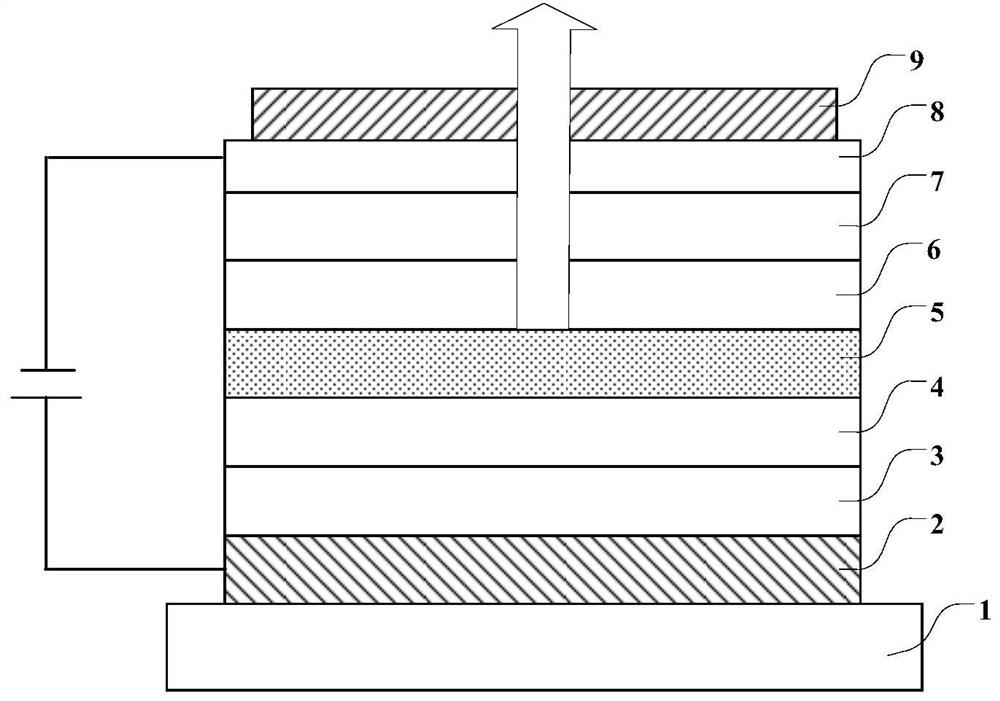Compound, luminescent material, organic light-emitting display panel, and organic light-emitting display device
A technology for luminescent display and luminescent materials, which is applied in the fields of compounds, luminescent materials, organic light-emitting display panels and organic light-emitting display devices. Effect of improving luminous efficiency
- Summary
- Abstract
- Description
- Claims
- Application Information
AI Technical Summary
Problems solved by technology
Method used
Image
Examples
preparation example 1
[0125] Compound P1 was prepared by the following method:
[0126] Specific steps:
[0127]
[0128] Weigh S1 (8.0mmol), S2 (9.7mmol), K2CO3 (33.9mmol), CuI (2.0mmol), 18-crown-6 (0.82mmol), and dissolve in anhydrous dichlorobenzene under nitrogen atmosphere. Stir at 100°C for 12h. After the reaction, cool to room temperature. Extract with dichloromethane, collect the organic phase, and wash with anhydrous Na 2 SO 4 Dry processing. The dried solution was filtered, and the solvent was removed by a rotary evaporator to obtain a crude product. The crude product was purified by silica gel column chromatography, and the final purification gave solid S3 (4.8 mmol, 60%).
[0129] Characterization results: MALDI-TOF MS: m / z calcd for C 24 h 14 BrNS: 427.0; found: 427.3.
[0130]
[0131] At -78°C, S3 (2.0 mmol) was dissolved in ether (40 mL), and nBuLi (3.0 mmol) in n-hexane was added dropwise to the solution. The reaction solution was continuously stirred for 2 h, slow...
preparation example 2
[0134] Compound P3 was prepared by the following method:
[0135]
[0136] Specific steps:
[0137] Weigh S1 (6mmol), S5 (7.2mmol), K 2 CO 3 (25.2mmol), CuI (1.5mmol), 18-crown-6 (0.64mmol), dissolved in anhydrous dichlorobenzene under nitrogen atmosphere. Stir at 100°C for 12h. After the reaction, cool to room temperature. Extract with dichloromethane, collect the organic phase, and wash with anhydrous Na 2 SO 4 Dry processing. The dried solution was filtered, and the solvent was removed by a rotary evaporator to obtain a crude product. The crude product was purified by silica gel column chromatography, and the final purification afforded solid S6 (3.72 mmol, 62%).
[0138] Characterization results: MALDI-TOF MS: m / z calcd for C 27 h 20 BrNS: 469.0; found: 469.4.
[0139]
[0140] At -78°C, S6 (1.5 mmol) was dissolved in ether (40 mL), and nBuLi (2.2 mmol) in n-hexane was added dropwise to the solution. The reaction solution was continuously stirred for 2 h,...
preparation example 3
[0143] Compound P16 was prepared by the following method:
[0144]
[0145] In a 100mL three-necked flask, first S6 (10.0mmol), pinacol diborate (10.5mmol), (1,1,-bis(diphenylphosphino)ferrocene)dichloropalladium(II) (0.2 mmol) and potassium acetate (25.0 mmol) were added respectively, while stirring, degassing and nitrogen replacement were repeated 3 times rapidly, and 50 mL of tetrahydrofuran was added through a syringe. Stir at a certain speed, and heat the reactants of the obtained mixed solution to reflux at a reaction temperature of 80°C for 5 hours; after the reaction is completed, cool to room temperature and add 60 mL of water, extract with ether, and dry the obtained organic phase with anhydrous sodium sulfate , the solvent was distilled off, and purified by column chromatography to obtain intermediate S7 (7.7 mmol, 77%).
[0146] Characterization results: MALDI-TOF MS: m / z calcd for C 33 h 32 BNO 2 S: 517.2; found: 517.3;
[0147]
[0148] Under nitrogen ...
PUM
| Property | Measurement | Unit |
|---|---|---|
| thickness | aaaaa | aaaaa |
| thickness | aaaaa | aaaaa |
| thickness | aaaaa | aaaaa |
Abstract
Description
Claims
Application Information
 Login to View More
Login to View More - R&D
- Intellectual Property
- Life Sciences
- Materials
- Tech Scout
- Unparalleled Data Quality
- Higher Quality Content
- 60% Fewer Hallucinations
Browse by: Latest US Patents, China's latest patents, Technical Efficacy Thesaurus, Application Domain, Technology Topic, Popular Technical Reports.
© 2025 PatSnap. All rights reserved.Legal|Privacy policy|Modern Slavery Act Transparency Statement|Sitemap|About US| Contact US: help@patsnap.com



